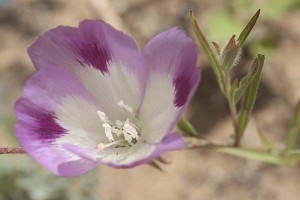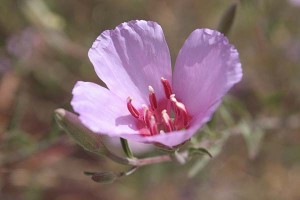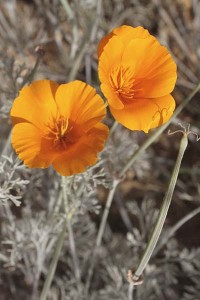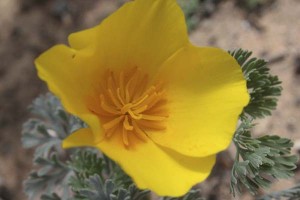Today’s Garden Bloggers’ Bloom Day post features five plants I’ve raised from seed. I’d consider most of these in the “pretty easy” to “really easy” categories, both to germinate and to grow.
Three of these came up from seed that I sowed directly in the ground last October. I basically made little furrows a quarter to half an inch deep, sprinkled in some seed, and watered them in. I provided some supplemental watering the give them a head start, and then let the occasional rains take care of getting the plants established. Now that the rains are probably over for the year, I give them occasional sprinklings to keep them greener and flowering longer.
This first flower is Clarkia williamsonii, which is an annual native to inland Central California and Orange County. The Seedhunt listing described the flowers as being “gaudy.” A flower that’s gaudy? Sold!
The next images are of another clarkia, Clarkia rubicunda ssp. blasdalei, native to coastal Central California and El Dorado County. The first is a freshly opened flower, the second a flower that’s on it’s second day.
Until this morning I’d never noticed with these that the fresh flowers have the stamens all bundled up, and that they don’t extend until the flower is older, after the anthers bearing the pollen are starting to dry up. You can see the stamens as the white four-pronged appendage in the center of the second flower. It’s a clever way to prevent self-pollination and keep the gene pool diverse.
Another easy annual is baby blue eyes, Nemezia menziesii. What you see here is pretty scrappy and well could be the last flower of the season. Although this is an easy plant, I’ve decided that it’s better suited to a garden spot that might get more than bi-weekly supplemental water.
I’ve been showing lots of California poppies this spring. This will probably be the last of the garden pictures of the common orange form. The flowers this time of year are starting to get smaller as the plant’s water supplies dwindle. Also, here near the coast, the plants start to mildew heavily, leaving them crippled. (You can see some of that as the whitish background foliage.)
Better suited to coastal areas is this yellow coastal form of the species, Escholzia californica maritima. The strain I’ve got starts to flower later in the year than the typical orange form, but the plants show much better resistance to powdery mildew and will continue flowering later into the year.
Unlike the first three plants I showed, the poppies are perennial, so the same plants will continue to come back one year to the next. But one nice thing with all these species is that they’ll come back from seed as well.
Check out all the other Garden Bloggers’ Bloom Day photos by checking out the listing at May Dreams Gardens.








It very satisfying when plants you have grown from seed flower
I got some seeds of clarkia in a seed swap and they are actually doing well. I hope they bloom like yours!
Very impressive! I’ve so far not managed to grow anything from seed by putting it into the ground. Maybe I’ll try again next fall. Will also try the coastal poppy, I do have a bad mildew problem on the “regular” kind myself though I usually get a second crop if I cut the first…
Both of the Clarkia are lovely flowers. I wouldn’t describe the williamsonii as gaudy. It has a more subdued pastel beauty IMO
Helen, the whole process comes closer to feeling like magic when you start from seed, doesn’t it?
Tina, good luck with your clarkias in your shady situation. Some of my plants get reduced sun and seem to be doing okay.
Town Mouse, I’ll have to admit that the seed process was a little dicey this year. My occasional “garden assistant” thought some of the first crop were weeds and yanked them. And the cat just LOVED the nemesia–I’d never heard of cats going crazy over it like catnip.
Wiseacre, I guess I was almost disappointed that they’re not gaudier than they are. A little 2-3 inch flower probably packs less gaudiness than something twice the size…
I like both of those clarkias. I prefer the mellower ones, and find the williamsonii pretty mellow, not so gaudy. Cool markings on it.
I have a hard time growing baby blue eyes. My neighbor does well with it but not linum. I do well with linum and not baby blue eyes. Fair enough, I guess.